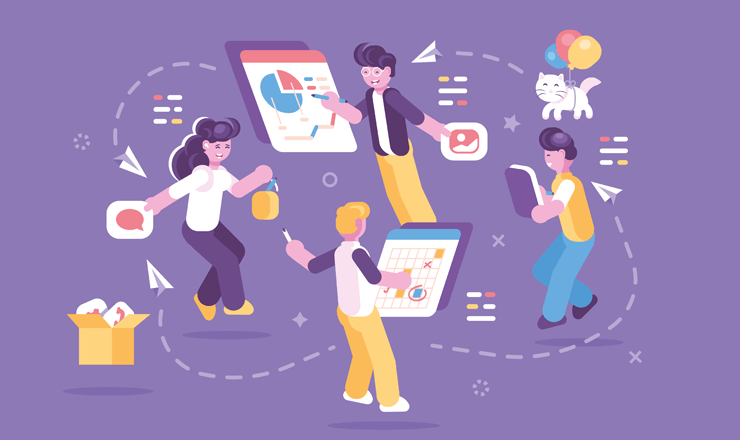With visual collaboration spreading rapidly, helping people transition to virtual workspaces everywhere, there are many questions floating around about what visual collaboration is and how it works. These questions need answers, and we decided to compile 15 of the most common questions and answer them in a visual collaboration Q&A. If you are interested in learning more about visual collaboration, check out our comprehensive guide, and if you need more convincing, read about visual collaboration’s various advantages.
Visual Collaboration Q&A
Q#1: What is Visual Collaboration?
If there’s one thing to take away from this visual collaboration Q&A, it should be our precise definition. Visual collaboration is a broad category and encompasses a variety of different features that center around you and your team being able to collaborate in real-time, in a shared space, utilizing visual elements to best convey your point. As stated in our comprehensive guide, the definition of visual collaboration is as follows:
“Visual collaboration is the practice of workplace collaboration driven by technology. It hinges on the ability for people to collaborate using visual elements as tools to expand their understanding and communicative abilities. Because visual collaboration tools are engaged online, this collaboration is capable from any place, on any device, in any way they want”.
Q#2: What are some of the main differences from traditional collaboration?
Most of the biggest differences around visual collaboration are not related exactly to their features, but their efficiency and convenience. Most things, from drawing to adding complex templates and charts, can all be done in person. But now they are available at the click of a button.
Not only are they available at the click of a button, but they can be accessed and utilized from anywhere, where normally workspaces are limited by their physical restrictions. In this sense, you can both use features that aren’t available traditionally while also accessing all the important established methods, and take your collaboration anywhere.

Q#3: Can you access it anytime?
Yes. One of the key value propositions of visual collaboration is that your work environment translates to a living workspace. This means that you can access and edit your workspace from any time, and from any place
Having your workspace transform into a living document means that people can reference it and gain knowledge at any time, while also being able to make meaningful contributions from anywhere.
This change makes visual collaboration tools highly flexible and demonstrates the versatility they possess over traditional collaboration methods.
Q#4: Is it secure?
Most tools don’t inherently deal with your data, but those that do mostly encrypt your data to make sure that what you’re working on stays secure. In general, you won’t have to worry about data security on these platforms. They understand that some things may require security and check the boxes where necessary.
Q#5: Is it just a whiteboard?
Virtual whiteboards are certainly the flagship tool of visual collaboration platforms, but they are certainly not the extent of their reach. Different platforms may emphasize project management or will attempt to combine the two.
To group visual collaborations into the title of virtual whiteboards would be a disservice to their features. They operate as more than a whiteboard, they are a visualization space to collect and disseminate ideas and work as interactive templates for teams to quickly adopt and work on together
Q#6: Isn’t it expensive?
Yes, and no. Pricing is a subject that is important to consider in-depth (and one we talk about extensively in our comprehensive guide). While visual collaboration tools are taxing for larger teams, this is a relative cost because connecting these many people physically would most likely cost far more than it would through collaboration tools
Tools mainly charge per user or by team size as part of a subscription plan, so costs can be leveled per user if you are operating from a smaller team.
Q#7: How many people can use it?
Most tools have different ways of capping users, but mainly they will have a limit depending on the price point you choose to operate at. When you scale up in price, you will usually gain some features while also gaining the ability to work with more people in your organization.
Some tools will allow you to have unlimited users within the same workspace, so in general, a maximum number of people is not something you will have to worry about.
Q#8: How do you get accustomed to using it?
There are many different ways to get accustomed to using visual collaboration tools, but the main method is simply using them more and more. You should try and use them every day to get used to using all the tools they have attached, and by using many different scenarios within them they will come more naturally as time progresses
If that strategy isn’t working, try the basic tutorials they provide. These tutorials walk you through the basic features of the tools and also will provide occasional tips for you to work well on the system in general
Q#9: How do you create a positive culture using visual collaboration tools?
Visual collaboration tools can be a big jump for some teams, especially those that are struggling to adapt to the virtual work environment. Getting people accustomed to using them quickly is important to use them effectively, and this comes from leadership and exposure.
Generating a positive collaboration environment and positive work culture stems from getting people involved and making sure everyone feels comfortable working together in this virtual space. When you actively engage your entire team on visual collaboration tools it helps generate a positive culture of honesty and contribution.
Q#10: How does it change productivity?
When people use visual collaboration tools to engage their team in their workspace, it allows them to communicate with more frequency and better efficiency. Communication is a great indicator of productivity, and those who communicate more usually produce more as well.
Not only is their communication increased, but they also streamline the collaborative process. Especially online where collaboration can be very stagnant and stuttered, visual collaboration tools can help increase everyone’s productivity.
Q#11: How well do they replicate traditional work environments?
Visual collaboration tools are very versatile and in many ways are meant to be used in tandem. When you use these tools alongside one another they combine to create a workspace that, while working in a virtual manner, functions very similarly to a traditional work environment.
Using tools side by side allows you to collaborate in real-time with your entire team, update and assign tasks, manage different projects throughout your teams, and get on video conference calls with them to iron out the details.
These tools working in tandem do a good job in recreating a traditional workspace, and with the addition of a messaging tool, there isn’t much left out.
Q#12: How can it help your business?
Real-time interaction is hard to come by online, and visual collaboration provides just that. Especially now in a time where most businesses are using remote workspaces, visual collaboration can provide real-time interaction between teams that extends further than a video call.
Yes, using video conferencing tools helps people work online together, but they fall short in collaborative settings. When people need to collaborate, being able to manipulate the same shared workspace is really important in order to add a much-needed layer of communication for your team.
Q#13: Does it improve communication between team members?
When team members are given multiple lines of communication through various tools, it becomes incredibly easy for them to communicate with one another.
Communication can occur in real-time and through visual mediums, which helps increase people’s ability to communicate and understand each other quickly.
Q#14: Where can you collaborate from?
One of the brilliant features of visual collaboration is it allows you to work from anywhere. Visual collaboration tools provide the flexibility to work both from home or from any remote location, meaning people can make meaningful contributions from anywhere they want.
Q#15: What kind of collaboration are you looking for?
There are multiple types of collaboration and in order for you to pick the right tools, you need to sort out which type you are looking to use. The main types of collaboration tools are virtual whiteboards and project management tools, and some attempt to blend the two into an all-encompassing workspace. Typically they are used in tandem, one visualizing the workspace and the other organizing the tasks and deadlines.
Learn more: What is Visual Collaboration?
Conclusion
Visual collaboration is very expansive and it can be difficult to sort out where you should start. Hopefully reading this visual collaboration Q&A guide has helped you determine if visual collaboration is right for your team, and by using this visual collaboration Q&A hopefully you can increase your team’s collaboration potential!
Most Recent Posts
Explore the latest innovation insights and trends with our recent blog posts.













